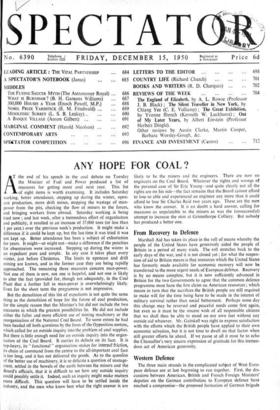ANY HOPE FOR COAL?
But the demolition of this list of expedients is not quite the same thing as the demolition of hope for the future of coal production, for the simple reason that the. Minister's list did not include the two measures in which the greatest possibilities lie. He did not include either the fuller and more efficient use of mining machinery or the reorganisation of the National Coal Board. To some extent he had been headed off both questions by the form of the Opposition motion, which called for an outside inquiry into the problem of coal supplies. But there is little enough need for an outside inquiry into the organ- isation of the Coal Board. It carries its defects on its face. It is top-heavy, its " functional " organisation makes for internal friction, its chain of command from the centre to the all-important coal face is too long, and it has not delivered the goods. As to the question of the better use of machinery, it is so delicate a question of manage- ment, settled in the bowels of the earth between the miners and the Board's officials, that it is difficult to see how any outside inquiry could possibly settle it. Indeed, such an inquiry might make matters more difficult. This question will have to be settled inside the industry, and the men who know best what the right answer is Are likely to be the miners and the engineers. There are now no engineers on the Coal Board. Whatever the rights and wrongs of the personal case of Sir Eric Young—and quite clearly not all the rights are on his side—the fact remains that the Board cannot afford to lose so able and experienced an engineer any more than it could afford to lose Sir Charles Reid two years ago. These are the men who know the answer. It is no doubt a hard answer, calling for measures as unpalatable to the miners as was the (unsuccessful) attempt to increase the stint at Grimethorpe Colliery. But nobody has produced a better one.






































